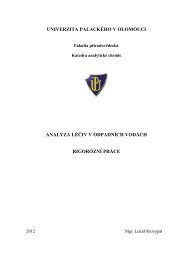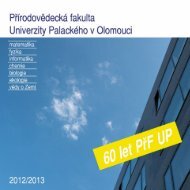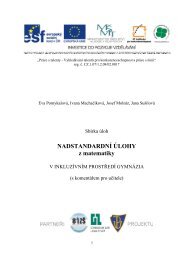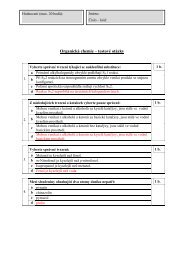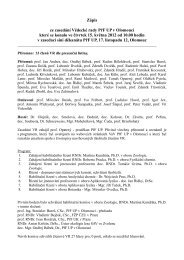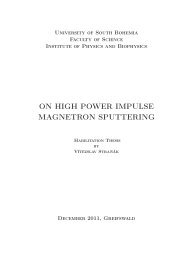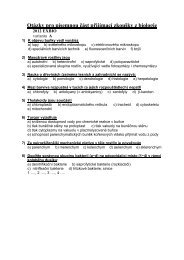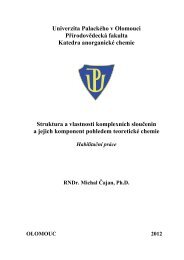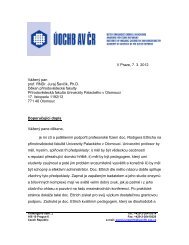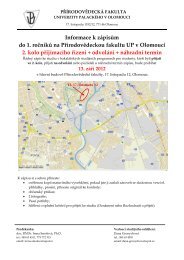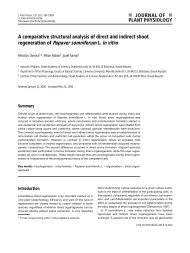ε-Fe2O3: An Advanced Nanomaterial Exhibiting Giant Coercive ...
ε-Fe2O3: An Advanced Nanomaterial Exhibiting Giant Coercive ...
ε-Fe2O3: An Advanced Nanomaterial Exhibiting Giant Coercive ...
You also want an ePaper? Increase the reach of your titles
YUMPU automatically turns print PDFs into web optimized ePapers that Google loves.
______________________________________________________________________________<br />
APPLIED PHYSICS LETTERS 99, 253108 (2011)<br />
Room-temperature ground magnetic state of e-Fe 2 O 3 : In-field Mössbauer<br />
spectroscopy evidence for collinear ferrimagnet<br />
Jiri Tucek, 1 Shin-ichi Ohkoshi, 2,a) and Radek Zboril 1<br />
1 Faculty of Science, Departments of Experimental Physics and Physical Chemistry, Regional Centre<br />
of <strong>Advanced</strong> Technologies and Materials, Palacky University, Slechtitelu 11, 783 71 Olomouc, Czech Republic<br />
2 Department of Chemistry, School of Science, The University of Tokyo, 7-3-1 Hongo, Bunkyo-ku,<br />
Tokyo 113-0033, Japan<br />
(Received 4 September 2011; accepted 24 November 2011; published online 22 December 2011)<br />
e-Fe 2 O 3 is a remarkable iron(III) oxide polymorph exhibiting a large room-temperature (RT)<br />
coercive field, coupled magnetoelectric properties, and millimeter-wave ferromagnetic resonance.<br />
Despite great application potential, its room-temperature ground magnetic state is still under<br />
scrutiny. Employing in-field 57 Fe Mössbauer spectroscopy, we unambiguously demonstrate that at<br />
room temperature, e-Fe 2 O 3 behaves as a collinear ferrimagnet, hence excluding any canting of<br />
sublattice magnetizations. When exposed to an external magnetic field, e-Fe 2 O 3 can be modeled as<br />
a two-sublattice ferrimagnetic nanomaterial with the highest coercivity among all currently known<br />
ferrimagnetic (nano)materials. VC 2011 American Institute of Physics. [doi:10.1063/1.3671114]<br />
The e-Fe 2 O 3 is one of 4 crystalline polymorphs of<br />
iron(III) oxide; it exists only in a nanosized form and its natural<br />
abundance is very limited. 1,2 This form has been known<br />
since 1934, 2 and it remained quite unexplored for a long period<br />
of time. Recently, Jin et al. 3 found that the e-phase<br />
exhibits a giant room-temperature (RT) coercive field of<br />
2 T, a rather surprising discovery for a (nano)material,<br />
where the magnetic behavior is driven solely by Fe 3þ ions<br />
with a half-filled d-shell. In addition to that, e-Fe 2 O 3 has<br />
been recently reported to have coupled magnetoelectric<br />
properties 4 and to show a millimeter-wave ferromagnetic<br />
resonance, 5 raising thus significantly its application potential.<br />
The e-Fe 2 O 3 is well recognized nowadays as promising<br />
candidate for assembly of recording media with high coercivity.<br />
Potential applications have been foreseen in electric/<br />
magnetic field tunable devices and components in communication<br />
systems for suppression of electromagnetic (EM) interference<br />
and stabilization of EM transmittance. 2,4,5<br />
Conditio sine qua non to the use of e-Fe 2 O 3 in high-tech<br />
applications requires solution of problems linked to its synthesis<br />
and purity (e.g., low yields, a lack of precise control of<br />
the resulting product size, and presence of polymorphous<br />
admixtures). 2<br />
Apart from limitations arising from synthesis, there are<br />
certain open questions of the e-Fe 2 O 3 magnetic behavior that<br />
need to be unveiled. 2 Among several, one issue remains crucial.<br />
It is necessary to gain a correct description of the nature<br />
and type of e-Fe 2 O 3 magnetic regime at room temperature.<br />
Presently, e-Fe 2 O 3 is thought to behave either as a collinear<br />
ferrimagnet 2,3,6–9 or as a canted antiferromagnet. 2,10,11 The<br />
two different hypothesis describing the RT ground magnetic<br />
state of e-Fe 2 O 3 are affected by significant presence of Fe 2 O 3<br />
polymorphous admixtures which prevents the correct experimental<br />
data interpretation. In fact, the discrepancies in the<br />
data analyses arised from the use of techniques (e.g., magnetization<br />
measurements) being unable to distinguish various<br />
a) Authors to whom correspondence should be addressed. Electronic<br />
addresses: ohkoshi@chem.s.u-tokyo.ac.jp and zboril@prfnw.upol.cz.<br />
magnetic regimes. However, till now, there has been a lack<br />
of focused study on e-Fe 2 O 3 with a pure specimen using infield<br />
57 Fe Mössbauer spectroscopy (IFMS) carried out at<br />
300 K. In case of Fe 3þ -containing compounds like e-Fe 2 O 3 ,<br />
IFMS may provide information on a material’s magnetic<br />
structure comparable to those derived from neutron powder<br />
diffraction. 12<br />
In this work, we address the issue of e-Fe 2 O 3 RT ground<br />
magnetic state employing IFMS. To meet the study scope,<br />
for e-Fe 2 O 3 preparation, we chose a synthetic procedure that<br />
combines the reverse-micelle and sol-gel techniques as<br />
reported by Jin et al. 3 This procedure allows assembly of homogeneous<br />
single-phased specimen of e-Fe 2 O 3 origin (nanorods<br />
having length of 80 to 140 nm and width of 15 to<br />
40 nm), hence without any experimentally detectable<br />
admixtures of other Fe 2 O 3 polymorphs. 2 The synthetic<br />
approach employs SiO 2 matrix and Ba 2þ ions as stabilizing<br />
and phase-purity agents, respectively. 3 In all previous IFMS<br />
studies, the amount of a-Fe 2 O 3 and/or c-Fe 2 O 3 nanoparticles<br />
as extra components of the main e-Fe 2 O 3 phase brought extra<br />
free parameters in the fitting procedure of the magnetic<br />
response, thus providing unclear results. 6–11<br />
The macroscopic magnetic response of the prepared e-<br />
Fe 2 O 3 /SiO 2 nanocomposite was monitored by measuring the<br />
RT hysteresis loop (Fig. 1) using a superconducting quantum<br />
interference device (SQUID) magnetometer (Quantum<br />
Design). The sample magnetization values were recalculated<br />
with regard to the molar ratio of Fe 2 O 3 /SiO 2 (i.e., Fe 2 O 3 /<br />
SiO 2 ¼ 0.22, Ref. 3) and known SiO 2 magnetic response at<br />
300 K (paramagnetic behavior) under an external magnetic<br />
field (B ext ). The profile of the measured RT hysteresis loop<br />
resembles that one observed for e-Fe 2 O 3 : (1) a wide hysteresis<br />
loop area, (2) coercive field of 2 T, and (3) magnetization<br />
non-saturation in high B ext . 2 Using the law of approach<br />
to saturation, 13 we obtain a saturation magnetization value of<br />
20 Am 2 /kg that is close to that derived from previous studies.<br />
3,14 This value is expected when a net magnetization<br />
value of 0.30 l B per Fe is taken for e-Fe 2 O 3 . 2 In absence of<br />
B ext , the phenomenon of distribution in spin orientation<br />
0003-6951/2011/99(25)/253108/3/$30.00 99, 253108-1<br />
VC 2011 American Institute of Physics<br />
¯ ¯ ¯ ¯ ¯ ¯ ¯ ¯ ¯ ¯ ¯ ¯ ¯ ¯ ¯ ¯ ¯ ¯ ¯ ¯ ¯ ¯ ¯ ¯ ¯ ¯ ¯ ¯ ¯ ¯ ¯ ¯ ¯ ¯ ¯ ¯ ¯ ¯ ¯ ¯ ¯ ¯ ¯ ¯ ¯ ¯ ¯ ¯ ¯ ¯ ¯<br />
¯ ¯ ¯ ¯ ¯ ¯ ¯ ¯ ¯ ¯ ¯ ¯ ¯ ¯ ¯ ¯ ¯ ¯ ¯ ¯ ¯ ¯ ¯ ¯ ¯ ¯ ¯<br />
156




